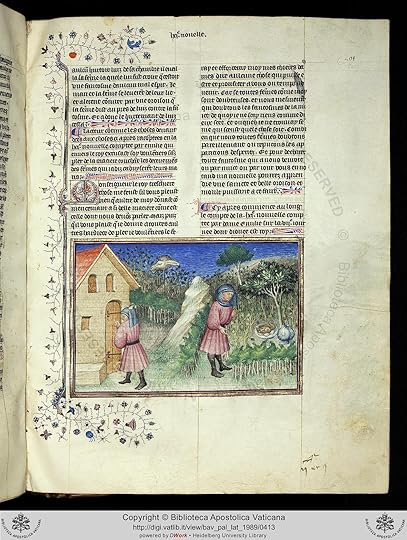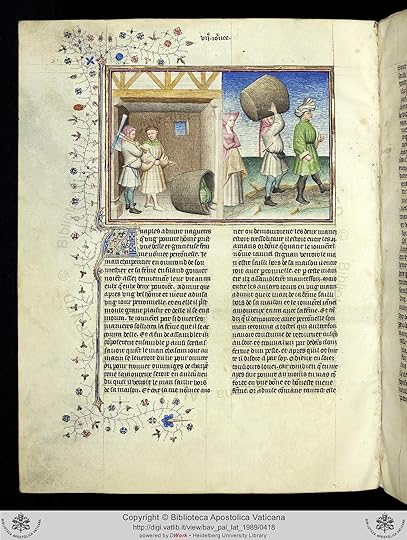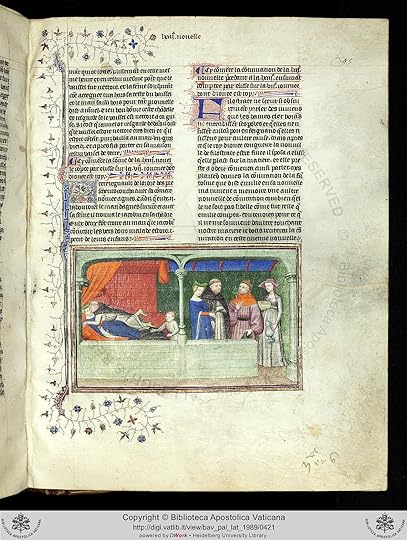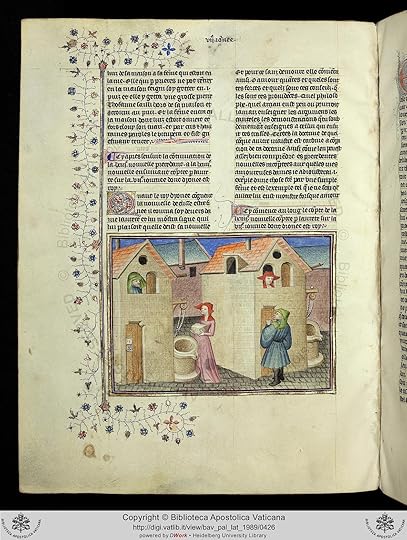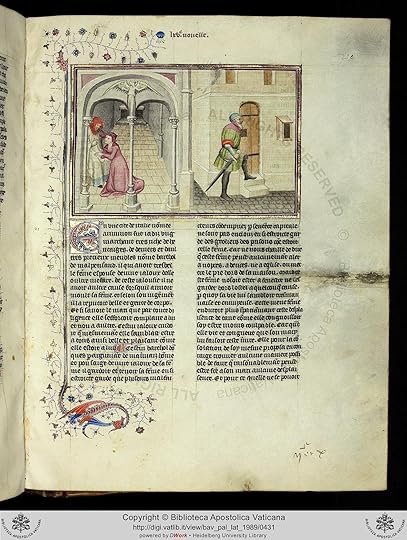Divine Comedy + Decameron discussion

This topic is about
The Decameron
Boccaccio's Decameron
>
8/25-8/31: Seventh Day, Introduction & Stories 1-5
date newest »
newest »
 newest »
newest »
message 1:
by
Kris
(new)
-
added it
Apr 14, 2014 09:35AM
 Mod
Mod
reply
|
flag
Helloooo. Is everyone away reading The Odyssey? lol
First tale =
Gianni Lotteringhi hears a knocking at his door at night: he awakens his wife, who persuades him that it is a werewolf, which they fall to exorcising with a prayer; whereupon the knocking ceases.
Emilia tells the first tale of the day. In it Boccaccio states that he heard it from an old woman who claimed it was a true story and heard it as a child. Although we will never know if Boccaccio really did hear the story from an old woman or not (it is possible), the story is certainly not true.
It resembles an earlier French fabliau by Pierre Anfons called "Le revenant." (I wonder if BP can get more info on this...)
Also, the English description of the creature as a "werewolf" is improper. The Italian word, fantasima describes a supernatural cat monkey creature or quite simply a ghost!
First tale =
Gianni Lotteringhi hears a knocking at his door at night: he awakens his wife, who persuades him that it is a werewolf, which they fall to exorcising with a prayer; whereupon the knocking ceases.
Emilia tells the first tale of the day. In it Boccaccio states that he heard it from an old woman who claimed it was a true story and heard it as a child. Although we will never know if Boccaccio really did hear the story from an old woman or not (it is possible), the story is certainly not true.
It resembles an earlier French fabliau by Pierre Anfons called "Le revenant." (I wonder if BP can get more info on this...)
Also, the English description of the creature as a "werewolf" is improper. The Italian word, fantasima describes a supernatural cat monkey creature or quite simply a ghost!
Second tale: Filostrato narrates this tale, which Boccaccio certainly took from Apuleius's The Golden Ass, the same source as tale V, 10.
The Metamorphoses of Apuleius, which St. Augustine referred to as The Golden Ass (Asinus aureus), is the only Ancient Roman novel in Latin to survive in its entirety. It's sometimes called one of oldest novel or first novel as well as Chariton's "Chaireas & Callirhoe"
Here it is :Lucius Apuleius The Golden Ass-Book I http://www.poetryintranslation.com/PI...
The Metamorphoses of Apuleius, which St. Augustine referred to as The Golden Ass (Asinus aureus), is the only Ancient Roman novel in Latin to survive in its entirety. It's sometimes called one of oldest novel or first novel as well as Chariton's "Chaireas & Callirhoe"
Here it is :Lucius Apuleius The Golden Ass-Book I http://www.poetryintranslation.com/PI...
Third tale (VII, 3)
Friar Rinaldo lies with his godchild's mother: her husband finds him in the room with her; and they make him believe that he was curing his godson of worms by a charm.
Elissa tells this tale, which has so many similar versions in French, Italian, and Latin, that it is impossible to identify one as a potential source for this one. The relationship between a child's godparent and biological parent was considered so sacred at the time that intercourse between them was considered incest. This belief is ridiculed by Boccaccio in a later tale
Friar Rinaldo lies with his godchild's mother: her husband finds him in the room with her; and they make him believe that he was curing his godson of worms by a charm.
Elissa tells this tale, which has so many similar versions in French, Italian, and Latin, that it is impossible to identify one as a potential source for this one. The relationship between a child's godparent and biological parent was considered so sacred at the time that intercourse between them was considered incest. This belief is ridiculed by Boccaccio in a later tale
Fourth tale (VII, 4)
Tofano one night locks his wife out of the house: she, finding that by no entreaties may she prevail upon him to let her in, feigns to throw herself into a well, throwing therein a great stone. Tofano comes out of the house, and runs to the spot: she goes into the house, and locks him out, and hurls abuse at him from within.
Lauretta is the narrator of this very old tale. The earliest form of it is found in the Sanskrit Śukasaptati (The Parrot's Seventy Tales), which was compiled in the 6th century AD.
Śukasaptati, or Seventy tales of the parrot is a collection of stories originally written in Sanskrit. The stories are supposed to be narrated to a woman by her pet parrot, at the rate of one story every night, in order to dissuade her from going out to meet her paramour when her husband is away.
The stories frequently deal with illicit liaisons, the problems that flow from them and the way to escape those crises by using one's wits. Though the actual purpose of the parrot is to prevent its mistress from leaving, it does so without moralising. At the end of the seventy days, the woman's husband returns from his trip abroad and all is forgiven. Most of the stories are ribald and uninhibited, with some verging on the pornographic. The situations depicted in the stories not only test the bounds of marriage, some stray into taboo areas of incest and, in one case, zoophilia.
The collection is part of the Katha tradition of Sanskrit literature. Some of the tales are actually repeated from earlier well-known collections in Sanskrit literature. In the tradition of Sanskrit literature, the tales are frequently interspersed with verse, many original, some repeated from earlier works. Though it is not known when it was originally written, current scholarship accepts that the collection was in its current form by the 12th century CE, though currently the oldest known manuscript dates back to the 15th century CE. The collection has been translated to many languages, including Persian in the 14th century, and in Malay, Hikayat Bayan Budiman, by a certain Kadi Hassan in 773 AH (1371 AD). It was last translated to English in 2000 CE.
http://en.wikipedia.org/wiki/%C5%9Auk...
Tofano one night locks his wife out of the house: she, finding that by no entreaties may she prevail upon him to let her in, feigns to throw herself into a well, throwing therein a great stone. Tofano comes out of the house, and runs to the spot: she goes into the house, and locks him out, and hurls abuse at him from within.
Lauretta is the narrator of this very old tale. The earliest form of it is found in the Sanskrit Śukasaptati (The Parrot's Seventy Tales), which was compiled in the 6th century AD.
Śukasaptati, or Seventy tales of the parrot is a collection of stories originally written in Sanskrit. The stories are supposed to be narrated to a woman by her pet parrot, at the rate of one story every night, in order to dissuade her from going out to meet her paramour when her husband is away.
The stories frequently deal with illicit liaisons, the problems that flow from them and the way to escape those crises by using one's wits. Though the actual purpose of the parrot is to prevent its mistress from leaving, it does so without moralising. At the end of the seventy days, the woman's husband returns from his trip abroad and all is forgiven. Most of the stories are ribald and uninhibited, with some verging on the pornographic. The situations depicted in the stories not only test the bounds of marriage, some stray into taboo areas of incest and, in one case, zoophilia.
The collection is part of the Katha tradition of Sanskrit literature. Some of the tales are actually repeated from earlier well-known collections in Sanskrit literature. In the tradition of Sanskrit literature, the tales are frequently interspersed with verse, many original, some repeated from earlier works. Though it is not known when it was originally written, current scholarship accepts that the collection was in its current form by the 12th century CE, though currently the oldest known manuscript dates back to the 15th century CE. The collection has been translated to many languages, including Persian in the 14th century, and in Malay, Hikayat Bayan Budiman, by a certain Kadi Hassan in 773 AH (1371 AD). It was last translated to English in 2000 CE.
http://en.wikipedia.org/wiki/%C5%9Auk...
A later version from the 11th century is found in Disciplina Clericalis, which was written in Latin by Petrus Alphonsi, a Jewish convert to Christianity. The tale was very popular and appears in many vernacular languages of the era.
Petrus Alphonsi (also known as Peter Alfonsi; born Moses Sephardi) was a Jewish Spanish physician, writer, astronomer, and polemicist, who converted to Christianity.
Born at an unknown date in the 11th century in Huesca, when the city still was part of al-Andalus (Islamic Spain), he embraced Christianity and was baptized at Huesca on St. Peter's Day, 29 June 1106. In honor of the saint Peter, and of his royal patron the Aragonese King Alfonso I and godfather he took the name of Petrus Alfonsi (Alfonso's Peter).
Petrus was born a Jew while living in al-Andalus, and after he rose to prominence, he converted to Christianity. This environment gave him an advantageous knowledge of Christianity, Judaism and Islam that would later prove useful in his polemics. John Tolan mentioned in his book Petrus Alfonsi and His Medieval Readers that "Alfonsi’s texts were received enthusiastically—he became an auctor, an authority to be quoted. His success was due in large part to his ability to bridge several cultures: a Jew from the [Muslim] world of al-Andalus." His knowledge of these different religions is what makes Alfonsi unique and why he is essential to be studied when looking at anti-Judaic polemics.
Petrus’ upbringing placed him in an atmosphere that provided a significant impetus to launch him as one of the most important figures in anti-Judaic polemics. According to Tolan, Petrus Alfonsi was reared in a society in turmoil: a place of chaos and political instability, where Judaism was in conflict with science, and Islam and Christianity were becoming a larger influence. His background was conveniently placed in the center of contention between religions and circumstances that surrounded his upbringing, and provided the framework for polemics that would shape Medieval Judaic perception.
Petrus Alphonsi (also known as Peter Alfonsi; born Moses Sephardi) was a Jewish Spanish physician, writer, astronomer, and polemicist, who converted to Christianity.
Born at an unknown date in the 11th century in Huesca, when the city still was part of al-Andalus (Islamic Spain), he embraced Christianity and was baptized at Huesca on St. Peter's Day, 29 June 1106. In honor of the saint Peter, and of his royal patron the Aragonese King Alfonso I and godfather he took the name of Petrus Alfonsi (Alfonso's Peter).
Petrus was born a Jew while living in al-Andalus, and after he rose to prominence, he converted to Christianity. This environment gave him an advantageous knowledge of Christianity, Judaism and Islam that would later prove useful in his polemics. John Tolan mentioned in his book Petrus Alfonsi and His Medieval Readers that "Alfonsi’s texts were received enthusiastically—he became an auctor, an authority to be quoted. His success was due in large part to his ability to bridge several cultures: a Jew from the [Muslim] world of al-Andalus." His knowledge of these different religions is what makes Alfonsi unique and why he is essential to be studied when looking at anti-Judaic polemics.
Petrus’ upbringing placed him in an atmosphere that provided a significant impetus to launch him as one of the most important figures in anti-Judaic polemics. According to Tolan, Petrus Alfonsi was reared in a society in turmoil: a place of chaos and political instability, where Judaism was in conflict with science, and Islam and Christianity were becoming a larger influence. His background was conveniently placed in the center of contention between religions and circumstances that surrounded his upbringing, and provided the framework for polemics that would shape Medieval Judaic perception.
Fifth tale (VII, 5)
A jealous husband disguises himself as a priest, and hears his own wife's confession: she tells him that she loves a priest, who comes to her every night. The husband posts himself at the door to watch for the priest, and meanwhile the lady brings her lover in by the roof, and tarries with him.
Fiammetta's tale most likely originates from a French fabliau or a possibly Provençal romance, both of which were recorded not too long before the Decameron was written.
Done with the week's reading, and it's only Tuesday! :)
A jealous husband disguises himself as a priest, and hears his own wife's confession: she tells him that she loves a priest, who comes to her every night. The husband posts himself at the door to watch for the priest, and meanwhile the lady brings her lover in by the roof, and tarries with him.
Fiammetta's tale most likely originates from a French fabliau or a possibly Provençal romance, both of which were recorded not too long before the Decameron was written.
Done with the week's reading, and it's only Tuesday! :)
 ReemK10 (Paper Pills) wrote: "Helloooo. Is everyone away reading The Odyssey? lol."
ReemK10 (Paper Pills) wrote: "Helloooo. Is everyone away reading The Odyssey? lol."Tee-hee. I'm reading The Name of the Rose (verah verah good!), which explains why I've fallen behind again. ^.^
I'll try to post the illustrations tomorrow or on Thursday at the latest (and to read the stories.. ^^).
Book Portrait wrote: "ReemK10 (Paper Pills) wrote: "Helloooo. Is everyone away reading The Odyssey? lol."
Tee-hee. I'm reading The Name of the Rose (verah verah good!), which explains why I've fallen behind again. ^.^
..."
Verah verah good eh? The talk is good about this book. I'll add it to my list. Thanks Beepers!
Tee-hee. I'm reading The Name of the Rose (verah verah good!), which explains why I've fallen behind again. ^.^
..."
Verah verah good eh? The talk is good about this book. I'll add it to my list. Thanks Beepers!
Hello, I am here and catching up. But I have to go back to the posts of last week.
BP, I have seen your updates of The Name of the Rose which I read years ago, but you are making me consider reading it again... I have other 14C books, at least a couple more, for next year.
BP, I have seen your updates of The Name of the Rose which I read years ago, but you are making me consider reading it again... I have other 14C books, at least a couple more, for next year.
 ReemK10 (Paper Pills) wrote: "Helloooo. Is everyone away reading The Odyssey? lol"
ReemK10 (Paper Pills) wrote: "Helloooo. Is everyone away reading The Odyssey? lol"No, no...just nothing sprung to mind to say about this section, aside from how witty the tales are...
 *comes out of gloomy monastery with bleary eyes*
*comes out of gloomy monastery with bleary eyes*I got lost in that labyrinthine library. Kinda spooky... Sorry about the delay. I'll get cracking on the illustrations now...
Hmm... First I need to get rid of some dusty stuff on my fingers...
*licks fingers*
^.^
 Illustrations - Day VII Story 1
Illustrations - Day VII Story 1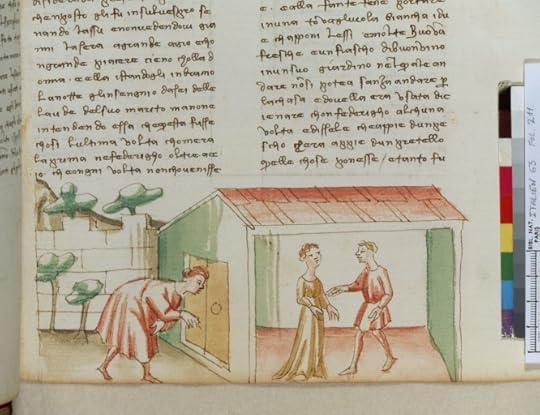
http://gallica.bnf.fr/ark:/12148/btv1...
Tessa dalla Cuculia abusant son époux
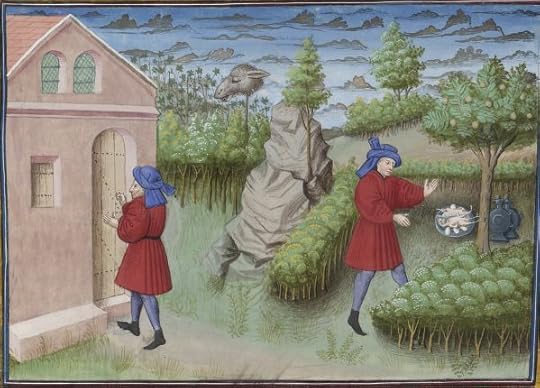
Source: gallica.bnf.fr
(view spoiler)
 Illustrations - Day VII Story 2
Illustrations - Day VII Story 2
http://gallica.bnf.fr/ark:/12148/btv1...
Giannello Scrignario sortant de la jarre

Source: gallica.bnf.fr
(view spoiler)
 Illustrations - Day VII Story 3
Illustrations - Day VII Story 3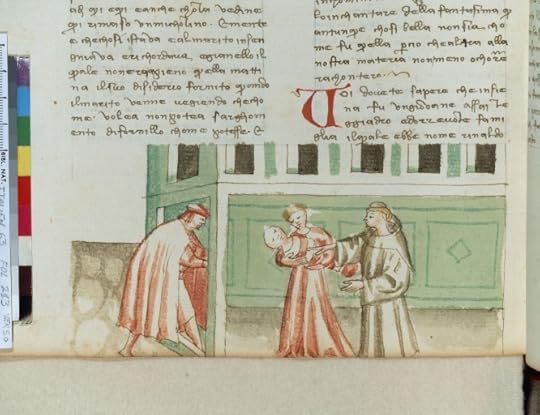
http://gallica.bnf.fr/ark:/12148/btv1...
Rinaldo abusant le mari d'Agnesa
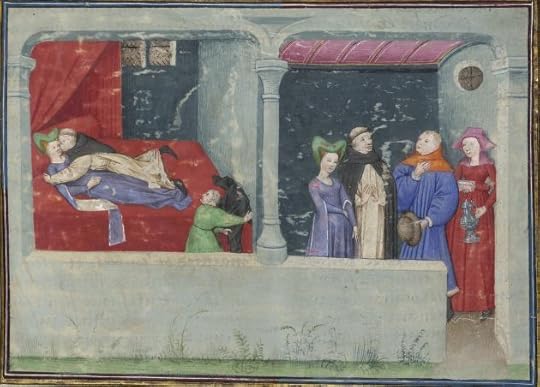
Source: gallica.bnf.fr
(view spoiler)
 Illustrations - Day VII Story 4
Illustrations - Day VII Story 4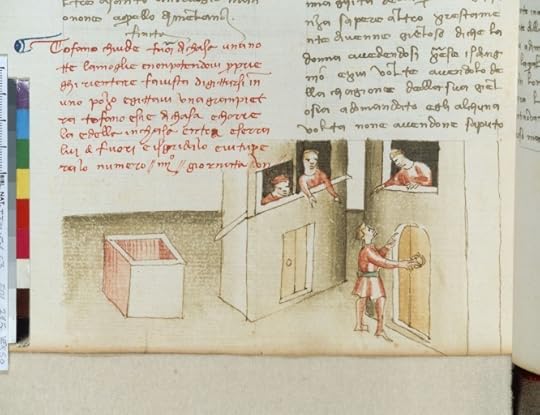
http://gallica.bnf.fr/ark:/12148/btv1...
Tofano à la porte de chez lui
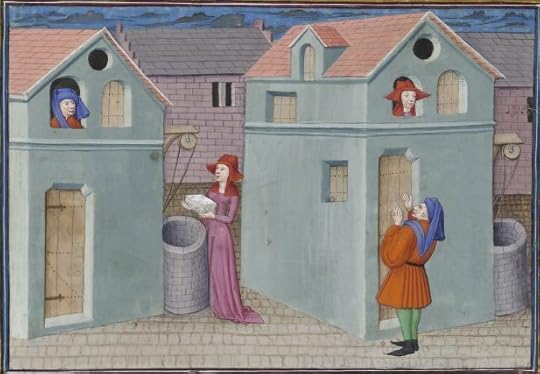
Source: gallica.bnf.fr
(view spoiler)
 Illustrations - Day VII Story 5
Illustrations - Day VII Story 5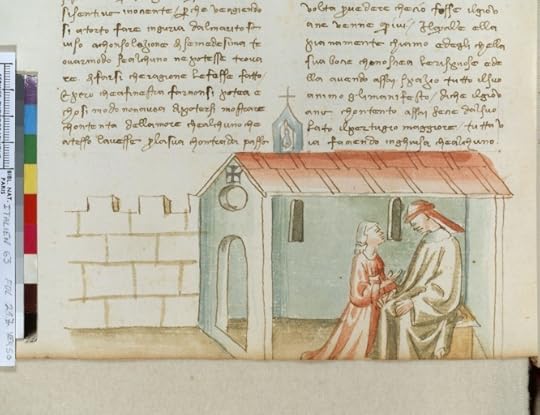
http://gallica.bnf.fr/ark:/12148/btv1...
Mari jaloux confessant sa femme
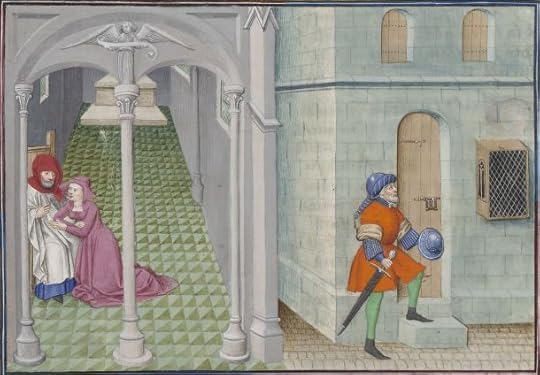
Source: gallica.bnf.fr
(view spoiler)
 ReemK10 (Paper Pills) wrote: "Helloooo. Is everyone away reading The Odyssey? lol
ReemK10 (Paper Pills) wrote: "Helloooo. Is everyone away reading The Odyssey? lolFirst tale =
Gianni Lotteringhi hears a knocking at his door at night: he awakens his wife, who persuades him that it is a werewolf, which they..."
I´m using a different translation (Payne) and it just says ¨phantom¨´.
 Book Portrait wrote: "Illustrations - Day VII Story 2
Book Portrait wrote: "Illustrations - Day VII Story 2http://gallica.bnf.fr/ark:/12148/btv1...
Giannello Scrignario sortant de la jarre
Source: gallica.bnf.fr
http://digi.vatlib.it/diglitData/i..."
Glad to see that one didn´t go into too much detail, BP, or I'd be repeating my George Takei impersonation, as when I read it......"OOOOHH, MYY!"
ReemK10 (Paper Pills) wrote: "Second tale: Filostrato narrates this tale, which Boccaccio certainly took from Apuleius's The Golden Ass, the same source as tale V, 10.
The Metamorphoses of Apuleius, which St. Augustine referr..."
Thank you, I plan to read The Golden Ass next year. I hope I remember this by then..
The Metamorphoses of Apuleius, which St. Augustine referr..."
Thank you, I plan to read The Golden Ass next year. I hope I remember this by then..
Book Portrait wrote: "Illustrations - Day VII Story 4
http://gallica.bnf.fr/ark:/12148/btv1...
Tofano à la porte de chez lui
Source: gallica.bnf.fr
http://digi.vatlib.it/diglitData/imag......"
I love the figures peeking through the windows.
http://gallica.bnf.fr/ark:/12148/btv1...
Tofano à la porte de chez lui
Source: gallica.bnf.fr
http://digi.vatlib.it/diglitData/imag......"
I love the figures peeking through the windows.
 Just catching up. Thanks Reem for the enlightening posts, in particular the ones on the possible sources for these tales. I couldn't find Anfons' fabliau but Boccaccio's version is enchanting. One thing that strongly came across in these tales is the anti-clerical sentiment. Boccaccio really didn't mince his words when he had his protagonists mock friars and bigots...
Just catching up. Thanks Reem for the enlightening posts, in particular the ones on the possible sources for these tales. I couldn't find Anfons' fabliau but Boccaccio's version is enchanting. One thing that strongly came across in these tales is the anti-clerical sentiment. Boccaccio really didn't mince his words when he had his protagonists mock friars and bigots...
Book Portrait wrote: "Just catching up. Thanks Reem for the enlightening posts, in particular the ones on the possible sources for these tales. I couldn't find Anfons' fabliau but Boccaccio's version is enchanting. One ..."
Yes, I was also surprised that Boccaccio was able to be so bold in his disapproval.
Yes, I was also surprised that Boccaccio was able to be so bold in his disapproval.
 Book Portrait wrote: "Just catching up. Thanks Reem for the enlightening posts, in particular the ones on the possible sources for these tales. I couldn't find Anfons' fabliau but Boccaccio's version is enchanting. One ..."
Book Portrait wrote: "Just catching up. Thanks Reem for the enlightening posts, in particular the ones on the possible sources for these tales. I couldn't find Anfons' fabliau but Boccaccio's version is enchanting. One ..."I remember reading "El libro de buen amor" in Brian Dutton's class (I was not a fan of medieval lit, but he made certain things come to life) and him bringing up this same criticism, but it was couched in other terms, and not so overt...
Books mentioned in this topic
The Golden Ass (other topics)The Name of the Rose (other topics)



